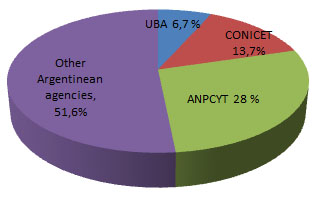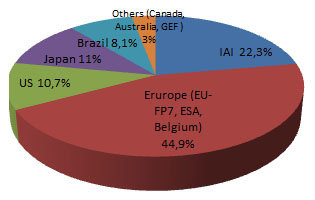Instituto Franco-Argentino de Estudios
sobre el Clima y sus Impactos
Projects
Funded Projects
Research activities at UMI-IFAECI are supported by a large and diverse set of grants awarded by the researchers of the unit.
A summary of the different funding sources is provided in Table 4.1,
while detailed information of the projects that have been under implementation between 2010 and 2013 are listed in Table 4.3.
The support of funding agencies from Argentina explains 45.9% of the total funding received between 2010 and 2013.
France funding sources have contributed with 3.5% while 50.6% of the funding came from other international sources.
The funding contribution of Argentinean agencies supporting 65 projects is largely explained by those supported by MINDEF and MINCYT.
In particular P40 (Table 4.3) intended to support the LIDAR/CEILAP group to develop a lidar network for Argentina, is a large project of
around 1.5 million euros, although the portion intended to actually support the group work between 2010 and 2013 is only reported here.
ANCYPT is the agency with the secondary contribution to the Argentina funding, while the others agencies are CONICET and UBA with smaller contributions (Fig. 4.1, Table 4.1).

Figure 4.1:
Distribution of the project funding source from Argentina among the different funding agencies.

Figure 4.2:
Distribution of the project funding source from France among the different funding agencies.

Figure 4.3:
Distribution of the project funding source associated to other international agencies besides those in Argentina and France.
The six projects supported by French funding sources started in the last two years because of the existence of UMI-IFAECI. The relative contribution is still small,
but it is expected to grow as an Agence Nationale Recherche (ANR) project recently approved (described in section 6b) will start in 2014 and many proposals are in preparation to be submitted soon.
Currently the French funding is mainly associated with CNRS/INSU/LEFE projects. In addition a project funded by CNES (P54, Table 4.3) started on 2013 to mainly support oceanographic observing activities in the South Atlantic.
In addition, partial support was received by some groups of the unit through a project funded by MEED (P91, Table 4.3).
Beside 21 projects are supported by other international funding sources. The largest contribution (Fig. 4.3) is associated with CLARIS-LPB, an EU-FP7 funded project,
with a strong South American – European interaction mainly based on the French-Argentinean one (discussed in section 6).
The projects supported by the Interamerican Institute for Global Change (IAI) also explain an important funding percentage.
These projects (like for example P11, P51, or P53) are collaborative research networks involving research groups of at least 5 countries.
Nevertheless only the funding supporting the activitity of the UMI-IFAECI research groups is reported here.
The Japan contribution is associated with a single project (P47) intended to improve and enhance the ozone observing capabilities in Argentina.
On the other hand Brazil contribution is mainly associated with a project supporting observing field campaigns in the South Atlantic (P50).
It is worth to mention that the implementation of the different research activities being performed at UMI-IFAECI in the context of all these projects,
include a large collaboration with many French researchers, as listed in Table 4.2. Between 2010 and present a total of 24 French researchers have collaborated and/or continue doing it with UMI-IFAECI researchers,
being 62.5% of them working at institutes encompassed by Institut Pierre Simon Laplace (IPSL).